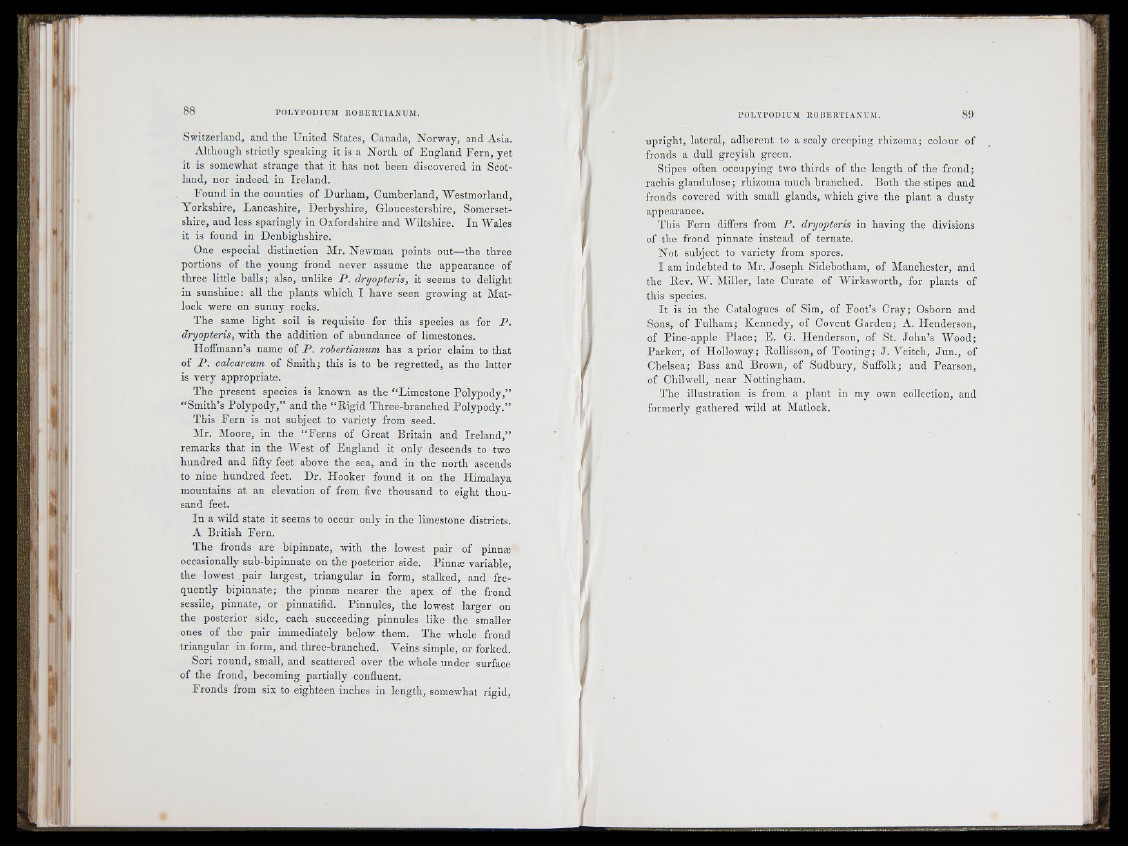
00 rOLYPOUIUM ROBERTIANUM.
Switzerland, and the United States, Canada, Norway, and Asia.
A lthough strictly speaking it is a N o rth of E n g lan d F e rn , yet
it is somewhat strange that it has not been discovered in Scotland,
nor indeed in Ire lan d .
F o u n d in the counties of Durham, Cumberland, Westmorland,
AVrkshire, Lancashire, Derbyshire, Gloucestershire, Somersetshire,
and less sparingly in Oxfordshire and AViltshire. I n Wales
it is found in Denbighshire.
One especial distinction Mr. Newman points out—the three
portions of the young frond never assume the appearance of
three little balls; also, unlike P . dryopteris, it seems to delight
in sunshine: all the plants which I have seen growing at M a tlock
were on sunny rocks.
T h e same lig h t soil is requisite for this species as for P .
dryopteris, with the addition of abundance of limestones.
Hoffmann’s name of P . rohertianum has a prio r claim to th a t
of P . calcareum of Smith; this is to be reg re tted , as th e latte r
is very appropriate.
T h e p resent species is known as the “ Limestone P o ly p o d y ,”
“ Smith’s P o ly p o d y ,” and the “ R ig id T hre e -b ran ch ed P o ly p o d y .”
This F e rn is not subject to variety from seed.
Mr. Moore, in th e “ F e rn s of Great Britain and Ire la n d ,”
remarks th a t in the AVest of E n g la n d it only descends to two
h u n d red and fifty feet above the sea, and in the n o rth ascends
to nine h u n d re d feet. D r. Ho o k e r found it on th e Plimalaya
mountains at an elevation of from five thousand to eight thousand
feet.
In a wild state it seems to occur only in the limestone districts.
A British F e rn .
T h e fronds are hipinnate, with the lowest pair of pinnæ
occasionally sub-bipinnate on the posterior side. Pinnæ variable,
the lowest p a ir largest, trian g u la r in form, stalked, and fre quen
tly hip in n a te ; the pinnæ n e a re r the apex of the frond
sessile, pinnate, or pinnatifid. Pin n u le s, the lowest larger on
th e posterior side, each succeeding pinnules like the smaller
ones of the p a ir immediately below them. The whole froud
trian g u la r in form, and three-hranched. Veins simple, or forked.
Sori ro u n d , small, and scattered over the whole un d e r surface
of th e frond, becoming partially confluent.
Fro n d s from six to eighteen inches in length, somewhat rigid.
p o l y p o d i u m R O B E R T IA N U ^ t. 8!)
u p rig h t, lateral, adherent to a scaly creeping rhizoma; colour of
fronds a dull greyish green.
Stipes often occupying two th ird s of the length of the frond;
rachis glandulose; rhizoma much branched. Both the stipes and
fronds covered with small glands, which give the plant a dusty
appearance.
Tliis F e rn differs from P . dryopteris in having the divisions
of the frond pinnate instead of ternate.
N o t subject to variety from spores.
I am Indebted to Mr. Joseph Sidebotham, of Manchester, and
the Rev. AV. Aliller, late Curate of AA^irksworth, for plants of
this species.
I t is in the Catalogues of Sim, of F o o t’s Cray; Osborn and
Sons, of F u lh am ; K en n ed y , of Covent Garden; A. Henderson,
of Pine-apple P lace; E. G. Henderson, of St. Jo h n ’s AVood;
P a rk e r, of Holloway; Rollisson, of T ooting; J . Veitch, Ju n ., of
Chelsea; Bass and Brown, of S udbury, Suffolk; and Pearson,
of Chilwell, near Nottingham.
The illustration is from a plant in my own collection, and
formerly gathered wild at Matlock.